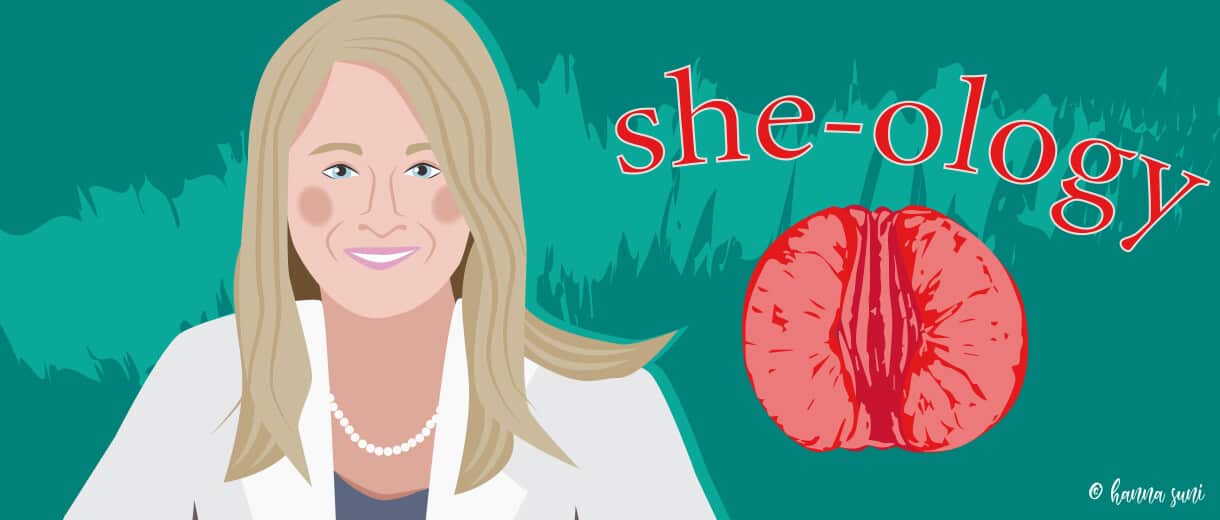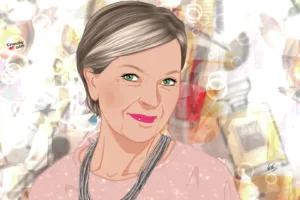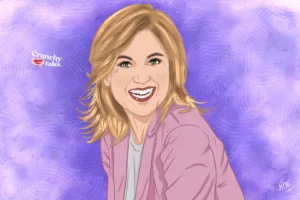Dr Sherry Ross: “Balance In Life and In The Vagina Goes Hand In Hand”
If there is a health expert who can flip the perspective about the ageing female body, it is Dr Sherry Ross. The American Ob/Gyn and author has been a fierce advocate of women’s health for over 25 years. Her first book She-ology: The Definitive Guide to Women’s Intimate Health was named one of the six ‘Most Life-Changing Wellness Books of 2017‘ by Prevention.com and Women’s Health Magazine. Her second book, She-ology, The She-quel: Let’s Continue the Conversation, was released in February 2020 and continues to be a bestseller.
CrunchyTales meets the physician who is revolutionising the way women look at their intimacy and who clearly has an agenda: challenging women and others to change the narrative on female healthcare especially as we age.
Dr Ross, there are so many healthcare issues that women in their midlife need to discuss that has nothing to do with menopause. However, it looks like it’s becoming the only mainstream for women over 40; most of the time the way it is treated and considered is more like a disease rather than a natural phase of our life and the media keeps offerings prét-a-porter solutions to overcome what is considered a problem, contributing to creating new age-related stereotypes and labels. How can we reframe this particular moment of our life beyond clichés?
We as women need to champion each other and lead by example especially as we age. We need to start conversations with our friends, our sisters, our children and anyone who will listen. We all need to be our best health advocates, especially when it comes to the vagina. We as women need to lead by example and help each other start a new narrative for ourselves, our bodies and our vaginas. Being happy and feeling empowered is the first step in changing the roadmap of our health and enjoyable ageing. We need to turn the shame and anxiety when discussing these sensitive medical topics into pride and a new sense of comfort and ease especially in menopause and beyond.
You are often called ‘the vagina crusader’. What are the pillars of your ‘vagina revolution’?
Some call me a Vagina Crusade, Vagina Activist or Vagina Whisperer. Others call me outspoken. My 3 sons call me embarrassing, but whatever the label, I am here to empower you to talk about your bodies. The vagina revolution is a metaphor for women’s need to talk about their specific healthcare issues, issues that are so often ignored. There are very few places where women feel comfortable talking about their vaginas without feeling judged, so at the very least, a doctor’s office should be a bastion of comfort. Unfortunately, this is usually not the case. Sadly, the conversation with your healthcare provider probably goes something like this: “Are you having any problems with your period? Any menopausal issues? Okay, great, now skootch down. In the blink of an eye the visit and conversation are over“. There are so many issues women need to discuss their healthcare that have nothing to do with pap smears, periods or yeast infections. Aside from the sensitive issues of painful sex, inability to have an orgasm, vaginal dryness with sex and vagina insecurity, there are the difficult subjects of depression, anxiety, hormone imbalance and domestic violence. All of this has led me to wonder why we’re so squeamish about the term vagina, and what we can do to reclaim the word and take back our bodies for our health, pleasure, and sense of personal power. The core issue is pretty simple really, we need to talk about it. It’s time to feel shameless-the Vagina Revolution has begun!
In your interviews and books, you often talk about ‘vagina insecurity’. Do you think these feelings of inadequacy increase with ageing or is there a chance we can grow more confident about our sexuality over the years?
Ageing is challenging to the vagina and all activities associated with it. Sex, bladder issues, vaginal burning and dryness, painful intercourse, difficulty having an orgasm, and losing sexual desire are all issues that can create vagina insecurity. More than 50% of women never talk about their vaginal health with anyone, not even their healthcare provider; 90% of women say they think we need better vaginal health education; 8 out of 10 women say they have experienced vaginal issues in the past year. Women, we need to make our vagina a health priority and talk about whatever issues we might be experiencing with it. I encourage all my patients to help me change the status quo on how we talk about our bodies. We need to create a movement for standing up for our vaginas and learning ways to avoid problems and promote health and wellness.
What are your views on Vaginal cosmetic surgery?
I have definitely seen an increase in women’s interest in having the conversation about how their vaginas compare to other women and if surgery is actually necessary. Porn and its accessibility have made it easy for women (and men) to compare their vagina’s to others with a quick search on Google. Social media and porn have given women vagina insecurity. I try and reduce my patients’ anxiety about their vaginas and reassure them that different is normal by frequently pulling out the mirror during a pelvic exam and going over my patient’s vagina and all its glory. While a wide range of variety is the norm when it comes to vaginas, there are women out there who do have abnormal labia. The most common symptom is the need to fold up their labia and push them into their vaginas in order to reduce the appearance of excess tissue or a bulge in their underwear or bathing suits. Other symptoms include labial pain, swelling, irritation, poor hygiene, and interference with athletics or sexual activity. Oversized or enlarged labia can impact athletics, such as running, bicycling, horseback riding, and swimming. Surgical procedures such as labiaplasty are available to improve these symptoms, as well as the appearance of the vagina if warranted. I feel as though the woman’s gynaecologist has to advise responsibility when a woman asked about having labiaplasty. Women hear about their friends getting labiaplasty probably more often than is truly indicated. As with any surgery, however, complications can occur. The most commonly seen side-effect of this procedure is painful scarring that can lead to discomfort during sex. Second or third opinions are always helpful if you find yourself unsure or confused about your doctor’s recommendation. The conversation of how women “size up” to others happens a lot more often than actually needing surgery to change the appearance of the vagina. In truth, I perform very few labiaplasties of the vagina each year. Education provides comfort and confidence!
In your opinion why there are still so many taboos about sex in midlife and beyond?
Ageing, in general, is not embraced by our culture. Women don’t want to admit they are in menopause knowing the eye of the storm is in the near future. The conversation of ageing alone is taboo along with the negative effects of what happens in the bedroom. When you enter the next chapter of life, called menopause, your estrogen and testosterone levels both drop affecting your desire to be sexually and intimate. Over 60% of women will report losing their libido. You are being bombarded with physical and emotional symptoms that directly affect your mood in the bedroom. Many women would rather be doing the laundry than have sex with their partners. This can create a lot of disruption in a relationship since over 30% of women stop having sex altogether. Menopause is brutal to sexual wellness and the vagina for women. These topics have been taboo for way too long. The time is now to bring them out in the open and continue the conversation so women can continue to live their best lives even with ageing. The bottom line is that quality of life, especially in the bedroom, is incredibly important and should be a priority. Expect the unexpected as your body transitions into menopause. Menopause is a natural process and everyone goes through it differently. Take good care of yourself through diet and exercise. Communicate openly with your partner so they know what you are going through.
The hilarious and yet very intelligent Netflix TV Series ‘Grace & Frankie’, starring Jane Fonda and Lily Tomlin, has allowed many of us to rethink sexuality at midlife in a more carefree and joyful way. They even talk about the importance of using ‘lube’ to keep vagina dryness at bay. How can we be more sexually confident at this age?
Despite life’s expected obstacles and hormonal challenges, a sexual and intimate life reminds you that your body deserves to be celebrated and pleasure may be within an arm’s reach. Hydrating and moisturizing the vagina with hyaluronic acid inserts in your 30s and 40s will prevent this debilitating condition. When you transition into menopause and decide not to be on hormone replacement therapy, the vagina suffers dramatically. Often, the hot flashes will improve over time but vulva-vaginal atrophy only worsens. In the vagina specifically, estrogen increases blood flow to the tissue, thickens the vaginal walls and helps with overall lubrication. With menopause and the loss of estrogen stimulation in the vagina, the tissue becomes dry and pale. The medical term for this is vulva-vaginal atrophy (VVA) or genitourinary syndrome of menopause (GSM) since the bladder is also affected. As a result, intercourse and other forms of vaginal contact become painful and often impossible. There are many treatment options including HRT, vaginal laser, and lubricants that can help with VVA. Lubricants are a bandaid to the delicate vaginal tissue during vaginal penetration in menopause. Taking care of the vulva and vagina decades before menopause is the most helpful remedy for menopause’s effect on the vagina.
In your new book “She-Ology: the she-quel” you write about Vaginal Mapping? What is that and why we should be interested in this practice, especially at our age?
Vaginal Mapping refers to a technique of receiving help in becoming familiar with your genitals in a way that is not only pleasant but not medical, clinical, sexual, or unexpected. It’s a way of getting to intimately know your vagina, vulva, and pelvic floor. The very existence of Vaginal Mapping shows how far women have come these days in their sexual awakening. In fact, women have described Vaginal Mapping—which not only utilizes touch, but mindfulness and breathing techniques—as a way of becoming truly relaxed, aware, and present in the moment. Vaginal Mapping uses purpose and intention as a means of getting to know all parts that make you female. Breast mapping is also included in this vaginal awakening process. To me, this “mapping” process simply codes for learning to embrace your femininity and your sexual health without shame. It is all about getting to your know body from head to toe and experiencing a full-body awakening. Having a physical and emotional relationship with your vagina and learning about the ins and outs of your body and your sexuality at an early age will probably save you money on your therapy bills as an adult. However, instead of paying up to $1200 for three sessions of vaginal mapping, why not learn about your own body for free? I often pull out a mirror to my new teen patients while their legs are in stirrups in order to go over the vulvar area, so they know where a tampon goes, where urine comes out, and where the clitoris is. Everyone needs a roadmap because understanding your vagina, clitoris, and your pelvis will help avoid problems relating to sexual dysfunction and disconnect with your own body. I can’t tell you the number of young women who have never looked at their anatomy, and the number of women who have been in sexual relationships yet have never masturbated or had an orgasm. It is imperative, at any age, to be aware of every part of your body without fear, inhibition, or embarrassment, and to know what makes your sexuality tick.
You often recommend we should take care of our vagina as well as we do with our face. What simple routine would you suggest for women in their middle age?
Balance in life and balance in the vagina go hand in hand. The vagina is normally acidic. This sounds pretty scary, however, it is the preferred pH balance and perfect for the many protective organisms which all live happily together in the vagina. Its skin is susceptible to dryness if not taken care of properly, especially with estrogen fluctuations in peri-menopause and absence in menopause. Helpful hygiene rituals include using a gentle, non-fragranced soap and natural skin moisturizer daily especially ones made specifically for the vagina. Taking a 20-minute warm bath with a handful of extra virgin coconut oil 3 to 4 times a week will also rehydrate the skin of the vagina. Adding oral or vaginal probiotics to your daily regimen will also keep the vagina hydrated and in complete balance and harmony. Avoid scented soaps, cleaners and feminine intimate grooming products that can actually upset the normal pH balance of the vagina, causing infections and skin irritation. I am coming out with its first of its kind to clean and healthy skincare for your vulva and vagina skincare line called URJA Intimates in mid-November; a three-step skincare routine to cleanse, hydrate and moisturize your most intimate areas.
Some of us are familiar with Pelvic floor exercises to increase internal toning, are there any specific exercises you suggest for our Vaginas?
Kegel exercises help make the muscles in your pelvic and vaginal area strong. These pelvic floor muscles support the uterus, bladder and bowels which control bladder and bowel function. The easiest way to identify your pelvic floor muscles is to pee and while doing so stop the flow of urine midstream and hold it. Hold the contraction for 3 seconds then relax allowing the flow of urine to continue. Repeat this a couple of times and you will have identified your Kegel’s muscles. Another way to identify your Kegel muscles is to insert your first two fingers into the vagina and squeeze your pelvic muscles as if you are holding urine. You should feel your vagina tighten and your pelvic floor move upward. Then relax your muscles and feel your pelvic floor return to the starting position. Kegel excises are meant to strengthen the pelvic floor muscles. There are many reasons why you can weaken your pelvic floor muscles, from pregnancy and childbirth to ageing and being overweight. The effect of weakening the pelvic floor results in your pelvic organs dropping and creating a bulge in your vagina. When this occurs it is called pelvic organ prolapse. Symptoms from a prolapse range from uncomfortable pelvic pressure to leakage of urine. Kegel exercises can help delay or even prevent pelvic organ prolapse and other related symptoms. If done correctly and repeatedly over time, you can avoid symptoms such as stress and urge incontinence caused by childbirth, ageing and obesity. Kegel exercises can also make sexual intercourse more enjoyable for you and your partner. You will notice a benefit to your pelvic floor strength in 8 to 12 weeks when done faithfully.
We love the way you talk and write about sensitive topics with such a joyful approach. Has writing your empowering books also helped you reconnect with yourselves and your needs as a middle-aged woman? If so, in which way?
As a women’s health educator, I am constantly talking to women and hearing new medical concerns and stories occurring due to ageing and hormonal changes. As I transition into menopause, I have personally witnessed the bodily changes, both physically and emotionally, that occur with the lack of estrogen. It’s transformative and I am on a mission to improve the quality of life for all women of all ages. Ageing should be embraced by women. I am here to empower women to have courageous conversations about their bodies. I want to speak out and stand up for the most vulnerable and voiceless among us. I do have an agenda. It includes encouraging women to take control of their health and well-being and I am challenging women and others to change the narrative on women’s healthcare especially as we age.
Like this article? Sign up to our newsletter to get more articles like this delivered straight to your inbox.





